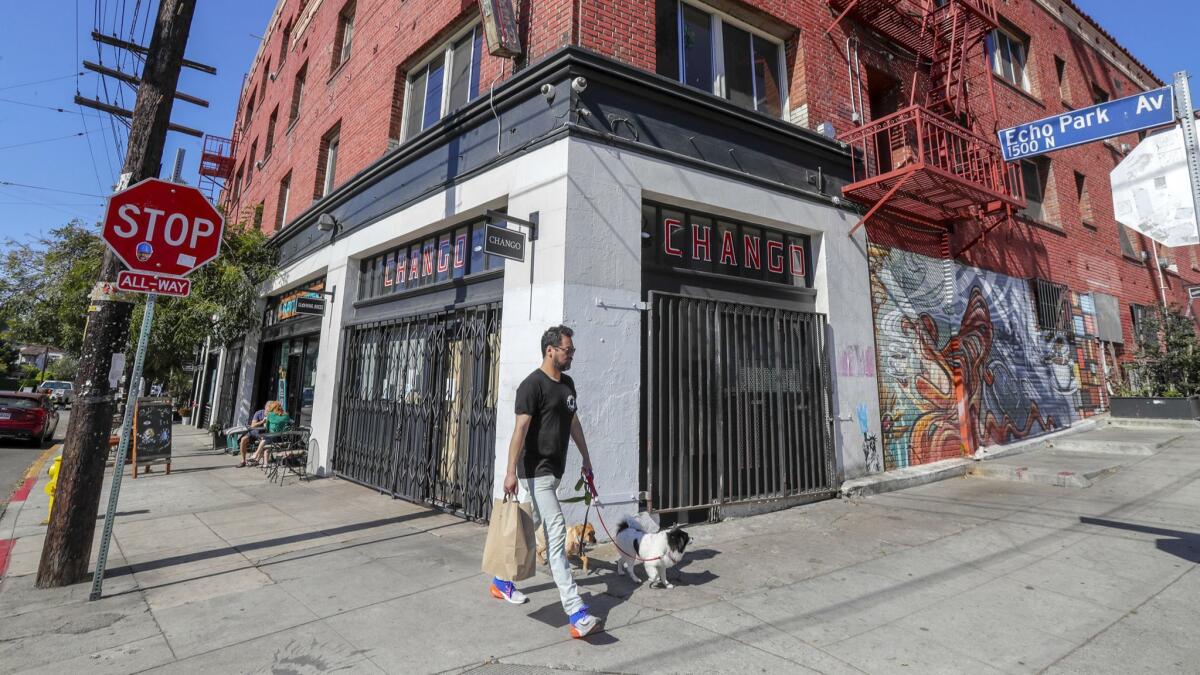Op-Ed: Can L.A. build new parks and public spaces without gentrifying away low-income residents?

- Share via
Concerns about gentrification in Los Angeles have reached the point where it’s not just art galleries and coffee shops that trigger alarm bells — parks and bicycle paths are in the crosshairs. Things are so bad that a proposal to improve bike safety and pedestrian access to parks along the Los Angeles River was recently denounced as “a gentrification scam” on social media.
These concerns are heightened due to hundreds of millions of dollars in public funds being invested in parks and other public spaces along the river and across the county — thanks in large part to statewide environmental bond measures passed in recent years. More funding is coming soon through Measure A, a parcel tax approved by Los Angeles County voters in 2016. Public agencies are increasingly prioritizing these investments for under-served communities that have historically not had access to parks.
Park, health-equity and environmental-justice advocates rightly applaud these investments. The benefits of regular access to nature, recreation and public spaces are well established.
But fear of “green gentrification” is also legitimate. Around the country there is evidence that parks added to low-income communities have contributed to displacing the very residents they were intended to serve. Think of the iconic High Line in New York City or the 606 in Chicago, where abandoned rail tracks were transformed into linear elevated parks that are now flanked by multimillion-dollar condominiums.
Other factors also contribute to gentrification, of course. Improvements in transportation, such as extending Metro rail lines, and capital investments in market-rate housing, retail and office space are key drivers of gentrification. But with billions of dollars slated to be invested in the coming years in parks, green infrastructure, stormwater management and multimodal transportation, Los Angeles needs to strategize ways to invest in underserved communities without pricing residents out of those neighborhoods.
We’ve been studying the threat of green gentrification around the country — and how cities, agencies, nonprofits, and residents are responding — and we’ve seen three strategies be effective limiting gentrification as public spaces are added to historically disenfranchised neighborhoods:
Regulation
Los Angeles County and cities in the region can regulate or incentivize affordable housing near public investments, such as parks and transportation hubs. Rent control is the most obvious example, as well as the most controversial. Right now, rent control can only be applied to older apartment units. Passage of Proposition 10 this fall would enable cities to apply rent control to newer buildings and rental houses. But there are other options. Inclusionary zoning, for example. Cities could require that residential developments next to new parks include a high percentage of affordable units. Cities can also offer density bonuses to developers building housing near new parks, so that the more affordable units they include, the more total units they can build. Legalizing accessory dwelling units within or next to single-family homes, so-called “granny flats,” can also add to the supply of affordable housing.
Value capture
As neighborhoods are improved with new parks and public spaces, property values go up, and so do property taxes. Cities need to capture those increased tax revenues to invest them in ways that benefit the community at large. The best way to do that now is to establish what the state of California calls an Enhanced Infrastructure Financing District. Once an EIFD is established in an improving area, a portion of the higher property taxes can be dedicated for creating more affordable housing. An EIFD is under consideration now along the L.A. River within city limits.
Collaborative development
Wherever possible, parks and affordable housing should be jointly planned. A new group called the Los Angeles Regional Open Space and Affordable Housing Collaborative is trying to establish a precedent for this. The collaborative includes nonprofit groups and government agencies from both the parks and affordable housing sectors — groups that have sometimes been at odds. This kind of collaborative effort could also include public agencies and private developers. The scale of this solution is one project at a time, but imagine what could be done if groups historically in conflict with one another worked together toward common solutions.
Click here for the full Livable City archive
None of these strategies are silver bullets for solving the twin challenges of inequitable access to parks and affordable housing in Los Angeles, but they do give communities a range of options.
Local and statewide funding agencies increasingly are asking cities to implement antidisplacement strategies when they apply for public money for parks. for example, the proposed guidelines for Measure A that the L.A. County supervisors are slated to vote on this month, would give higher scores for competitive grants to cities with antidisplacement strategies.
Cities can get ahead of the curve — and move closer to the front of the line for park funding — if they show that they are proactive about preventing green gentrification and displacement instead of waiting until it’s too late.
Jon Christensen teaches at UCLA’s Institute of the Environment and Sustainability. Alessandro Rigolon is a professor in the Department of Recreation, Sport and Tourism at the University of Illinois at Urbana-Champaign.
More to Read
A cure for the common opinion
Get thought-provoking perspectives with our weekly newsletter.
You may occasionally receive promotional content from the Los Angeles Times.










